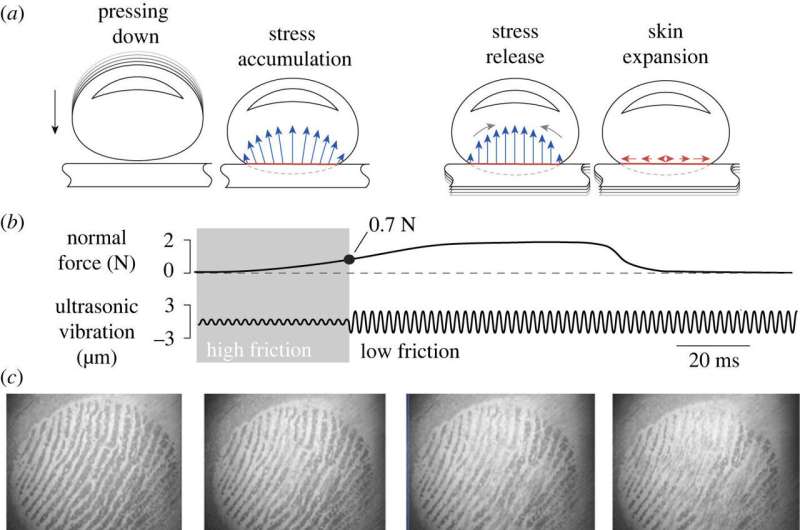Using ultrasound to mimic the feel of pressing a button on a glass plate

A pair of engineers at Delft University of Technology, working with a colleague at Aix-Marseille University, reports that applying ultrasound to the surface of a glass plate can mimic the feel of pressed button. Laurence Willemet, Michaël Wiertlewski and Jocelyn Monnoyer have published a paper in Journal of The Royal Society Interface describing the device they built to test the idea of using ultrasound as a haptic screen enhancer.
Currently, users pressing buttons on their smart phone screens do not receive much in the way of physical feedback—phone engineers would like to change that. In this new effort, the researchers looked into the idea of using ultrasound on a glass plate to mimic the sensations of pushing a physical button.
The researchers created the device by merging two modules. One used blue and red lights to optically track the movement of an approaching finger. The other monitored and responded to contact. Together, the modules controlled piezo actuators that generated ultrasound at a frequency of 28.85 kHz. The device was affixed to a glass plate, which in turn was held in place by an aluminum frame. When in use, the actuators were driven by a ±200 V carrier signal.
The resulting device was then tested using 12 volunteers—wavelengths of 2 micrometers exhibited a 75% chance of feeling like a button being pressed. The researchers noted that many of the volunteers reported that touching the plate really felt like the button below their finger was moving.
The researchers also used high-speed cameras to record the action to better understand the factors behind the sensation of button-pushing. They found that a human fingertip holds stress in the form of elastic energy. When a button is pressed (or simulated by ultrasound) that energy is released, resulting in relaxation of the skin on the fingertip, which feels like the action of a physical button. They also noted that the sensation is due to the ultrasound pushing the fingertip slightly away from the surface of the glass plate.
More information:
Jocelyn Monnoyer et al, Rapid change of friction causes the illusion of touching a receding surface, Journal of The Royal Society Interface (2023). DOI: 10.1098/rsif.2022.0718
© 2023 Science X Network
Citation:
Using ultrasound to mimic the feel of pressing a button on a glass plate (2023, February 8)
retrieved 8 February 2023
from https://techxplore.com/news/2023-02-ultrasound-mimic-button-glass-plate.html
This document is subject to copyright. Apart from any fair dealing for the purpose of private study or research, no
part may be reproduced without the written permission. The content is provided for information purposes only.
For all the latest Technology News Click Here
For the latest news and updates, follow us on Google News.

